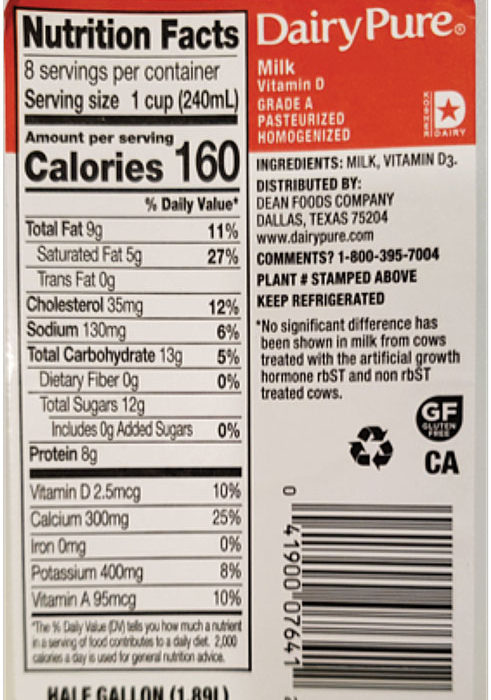
By: Mohammad Ahrar, PhD
Introduction
The nutrition facts panel on food packages can be a good shopping guide for consumers. Food labels provide necessary information about the content of a package and help consumers choose a food that contains high amounts of a nutrient that they need most. However, sometimes the information on food labels may be confusing. In this article, we will review the information listed on packaged foods and discuss how the information can help us decide which products to choose. We will also find out what the food labels do not tell us and what information is kept secret from consumers.
General information on the labels
When you do grocery shopping, it is important to pay attention to the labels. The nutrition facts on food labels includes the name of the food, net weight, serving size, total Kilocalories (or Calorie), measurements of total fats (including saturated fats and trans fats), cholesterol, sodium, carbohydrates, dietary fiber, sugars, vitamin A, vitamin C, percent Daily Value (%DV), name and address of manufacturer or distributor, and a list of all ingredients in the food. The actual amount (in milligrams or micrograms) for vitamin D, calcium, iron, and potassium should also be listed on the food packages.
The amount of sugar on the nutrition fact table gives important information to diabetics. When the label lists sugar, it means table sugar (sucrose), unless it says glucose. In any case, consumers should know how much sugar there is in the food they consume. The amount of salt or sodium as well as cholesterol and fats in a food may be of a concern for many people so that they can manage their health.
Serving size
A serving size is the first information that appears on a label and must be listed both by weight in grams and in common household measures, such as cups and ounces. It is a standard measurement based on the amount of food most people consume at one time. The serving size helps consumers calculate how many calories or a certain nutrient they can get from one serving.
For example, if a can of food contains 3 servings, and each serving contains 1,500 mg of salt, consuming the whole can would provide 4,500 mg of salt, which is almost twice as much recommended by the government (2,300 mg per day).
Let’s take a look at another example: A slice of sourdough bread is one serving size, providing 110 Calories. If you eat a sandwich with two slices of the bread, you’ve had two servings of bread, which provides 220 Calories, but this doesn’t include any spread or fillings.
Who regulates the food labels?
All food labeling on packaged foods in the United States is controlled and regulated by the Food and Drug Administration (FDA). The FDA is responsible for assuring that foods sold in the United States are safe, wholesome, and properly labeled. This applies to foods produced domestically, as well as foods from foreign countries. Food manufacturers and importers of food products must be fully informed about the applicable laws and regulations before offering foods for distribution in the United States. When it comes to fresh products such as fruits and vegetables that do not have labels, grocery stores must post basic information near where the foods are sold, and the FDA surveys a sample of nationwide grocery stores every two years.
Meat and poultry products are carefully monitored by the U.S. Department of Agriculture (USDA) for any microbial or other contaminants. USDA labeling laws ensure that meat and poultry products (pertaining to fish, frozen and processed meat, eggs, and poultry products) are safe, wholesome, and accurately labeled.
Examples of nutrition facts labels are shown below.

Serving size versus portion size
Portion size should not be confused with serving size. A portion size is what you choose to eat, or how much you eat. A plate of rice, a hamburger, or a bowl of salad are portion sizes. The USDA defines a portion as the amount of food eaten at one sitting. In contrast, a serving size (only used on nutrient labels), is a standard amount of food that shows the nutrient composition in that amount of food. For example, ½ cup of spaghetti that fills a small plate is considered one serving and provides about 300 Calories. This can be considered a small portion. A regular dinner plate holds about 3 cups (3 servings) of spaghetti. This can be considered a large portion and provides 900 calories. Most likely, people add more ingredients to the spaghetti plate, which adds up the calories they are receiving in one sitting.
There are no standard measures for the portion size, and it is consumers’ choice how much food they like to eat.
What does Daily Value tell us?
Daily Values (DVs) on food packages can sometimes be confusing. Simply, the DV means how much of a nutrient (such as protein) you need to eat in a day and how much of the content of the package provides that amount of nutrient in one serving. What you actually see on the nutrition facts label is the percentage Daily Value (%DV) of some nutrients in one serving of a food. For example, if your daily protein requirement is 55 grams, and you find the %DV for protein on the label listed as 20%, it means that in one serving only 20% of the 55 grams (about 11 grams) is provided in one serving. Therefore, you need to get an extra 33 grams of protein from other foods during the day. The same rule applies to other nutrients in the container. The %DVs are based on a 2,000-calorie diet needed per day for average healthy adults. Use of Daily Value can be very helpful for a quick comparison of different foods to ascertain which product provides more nutrients that are needed most, or which product produces fewer nutrients that you do not want.
According to the FDA, if you see the %DV of 5% or less of a nutrient on the food table, it is considered low or minimal amount of that nutrient. If the %DV on the label is 20% or more of a nutrient, it is considered high in the nutrient and should provide a good amount of that nutrient.
Label claims
Some food producers make claims such as “low cholesterol,” “low fat,” “gluten free,” “organic,” “no GMO,” or any other claims. All nutritional claims on food products are closely monitored by the FDA.
If a food producer makes a claim about a nutrient, that nutrient must be listed, and is closely monitored.
According to the FDA, fat-free or sugar-free means the food should contain less than 0.5 gram (g) of fat or sugar per serving. If the claim says cholesterol free, the food still can have up to 2 milligrams of cholesterol. Likewise, a sodium-free or salt-free food can have up to 4.9 mg (less than 5 mg) of salt or sodium per serving.
Information on the ingredients list
The list of the ingredients is usually written at the bottom or on the side of the food table. The FDA mandates that every single item in a food package should be mentioned on the label. The ingredients usually are listed in order from the largest to smallest amount by weight; a food made up of the heaviest amount is listed first and a food containing the least amount is listed last.
Checking the ingredients in a package becomes very important for healthy and health-concerned people, as well as for people with diabetes, heart problems, and other health issues.
What food labels don’t tell us

Although the FDA sets the standards and regulations for food products, there are instances that certain ingredients and chemicals may not be required to be written on the labels. Some foods such as plain coffee and tea, some spices, flavorings, deli items, bakery foods, and foods produced by restaurants and small businesses that have total sales of less than $500,000 per year are exempt from carrying a nutritional facts panel on food products. Therefore, some food manufacturers may take advantage of loop holes.
The problem is that some additives to a food product may be carcinogenic, and if the amount is less than the FDA guideline, the producer does not have to mention it on the food label. The U.S. Congress has actually passed special legislation preventing the FDA from restricting the use of the artificial sweetener saccharin, even though it has been shown to induce tumors in test animals.
In addition to saccharin, two known carcinogens—vinyl chloride and acrylonitrile—may appear at very low levels in food as a result of their application in the manufacture of plastics used in food-packaging materials. According to a recently adopted policy, these chemicals are considered by the FDA to be “constituents” of food-packaging material rather than additives (2).
Research shows that the link between processed meats and cancer may be due to the nitrates, nitrites, and/or sodium they contain; these ingredients contribute to the formation of nitrosamines, which are known carcinogens, yet are allowed in food products in limited amounts.
Besides additives, some methods of food preparation may not always be healthy. For example, charcoal-broiling of meat (such as when Kabob is burned) will result in the deposition of mutagenic hydrocarbons. Frying bacon that contains nitrite produces nitrosamines, which are considered carcinogenic (National Research Council, 1982). Mutagenic chemicals may also be produced as a result of oxidation of fats during frying at high heat.
Note- Some ingredients or additives in food products may be linked to or increase the risk of cancer, but the amount in one serving is considered safe and is approved by the FDA that can be added to a product (except for suspected carcinogens). In such instances, consuming more than one serving size my not be advisable. For instance, if 10 micrograms of a carcinogenic additive in one serving is considered safe, two or three servings of the food, over a long period of time, may not be safe and can cause cancer.
Summary
The nutrition facts label on packaged foods and cans provide important information to consumers for choosing the nutrients they want from the product, and avoiding the ingredients that they don’t want.
FDA regulates food labels on foods sold in the U.S. to assist consumers in maintaining healthy dietary practices.
Serving sizes, Percent Daily Value (%DV), and the list of ingredients are very useful tools for planning a healthy diet.
Selected References:
1- Nutrition; from science to you, Joan Salge Blake, Kathy D Munoz, and Stella Volpe-3rd ed. 2016, Pearson Education, Inc.
2- https://www.ncbi.nlm.nih.gov/books/NBK216714/


















